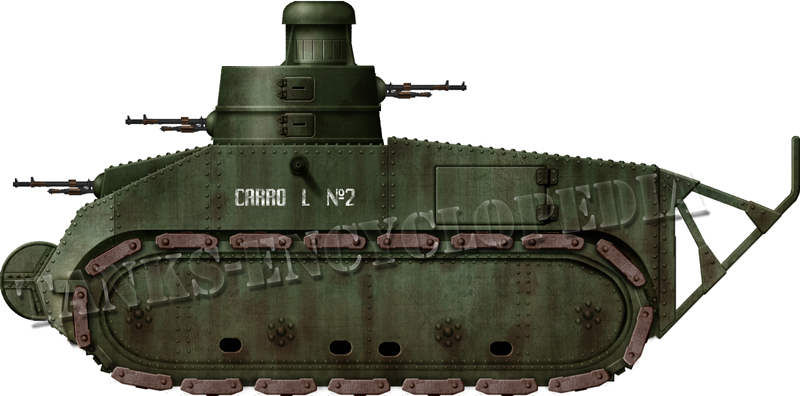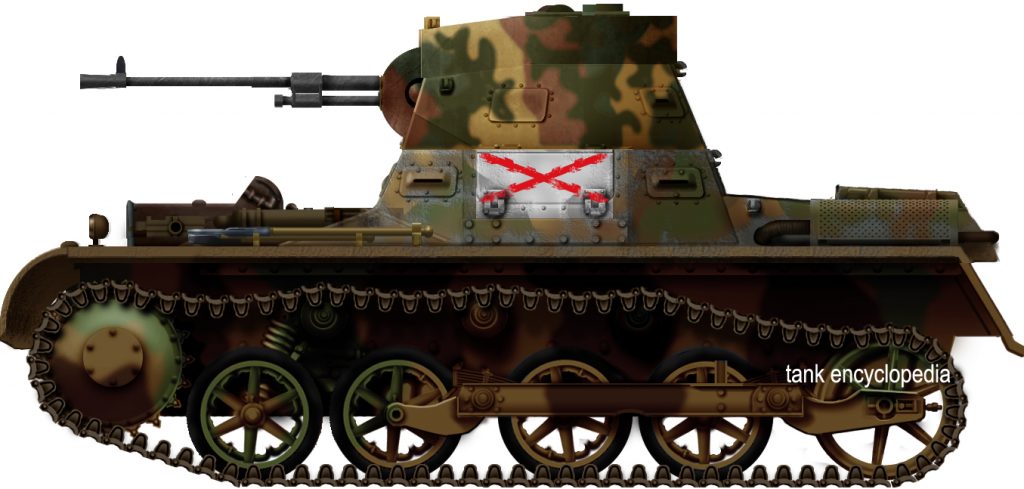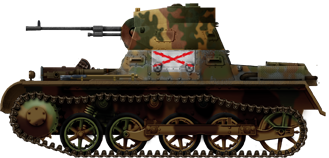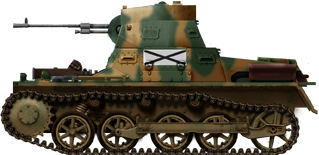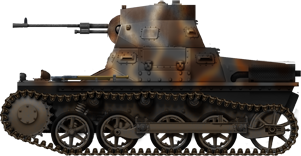

 Kingdom of Spain/Second Spanish Republic/Nationalist Spain (1926-1937)
Kingdom of Spain/Second Spanish Republic/Nationalist Spain (1926-1937)
Light Tank – 4 Built
Spain has mainly depended on foreign technology for its tank forces but there have always been enthusiastic engineers, military commanders, and policy-makers who have wanted to break the mold and create indigenous designs. The first of these initiatives would take place in 1925 in the northern town of Trubia, Asturias. Following the satisfactory completion of a prototype, plans were put in motion to design an improved serial production tank which was to be known as the Modelo Trubia Serie A4, or ‘Trubia tank’ for short.
Context – Lessons from Morocco
Colonial competition and internal politics meant that Spain took possession of large areas of what today is Morocco. The locals loathed the Spanish colonial administrators, leading to the Melilla War (1909) and the Rif War (1911-1927). In the latter, Spain would use for the first time in its history the modern technology of aircraft, armored cars, and tanks. The Spanish brought 11 Renault FT’s and 6 Schneider CA-1’s from France which would take part in multiple actions throughout the war with mixed results. The main shortcomings found in the Renault FT, regarded by the Spanish as their finest tank, were: poor performance, speed, range of operation due to a poor engine, and its vulnerability when its only machine gun jammed.
To overcome these, a team involving Commander Victor Landesa Domenech (an artillery officer attached to the Trubia arms factory), Captain Carlos Ruíz de Toledo (a Commander in charge of Batería de Carros de Asalto de Artillería [Artillery Tank Battery] during its first engagements during the Rif War) and the Trubia arms factory’s Chief Engineer, Rogelio Areces, took it upon themselves to design and build a superior vehicle for the Spanish Army.
The Trubia prototype
Designed and built in 1925 on their own initiative and financed out of their own pockets, the Trubia prototype would be tested in 1926 with a very satisfactory reception. So much so, that, a budget was set for the creation of a tank producing workshop at the Trubia factory and a commission led by Areces and Ruíz de Toledo was established to travel Europe and investigate tank technological innovations they could use for an improved serial version of the prototype.
Appearance-wise, the tank resembled the Renault FT, as it was in the minds of Landesa Domenech and co. the best tank they had knowledge of. However, there were a few differences:
– To surmount firepower concerns, two overlapping turrets with independent movement and each armed with a Hotchkiss 7mm machine gun were adopted.
– At the front of the tank there was a small semi-circular plate attached to an elongated nose of the tank which acted as a ram to break through obstacles such as walls and barbed wire.
– Due to circumstances, armor and engine-power were only marginally improved.

The European Expedition, Notions of Tank Design
Areces and Ruíz de Toledo’s European adventure would not be as fruitful as they may have hoped and expected. Tank technology was in its infancy and most tank producing nations were wary of sharing their findings, and the technology they did exhibit and share was mostly outdated. Companies like Vickers did at the time sell custom-made tanks to the buyer’s needs, but it seems that Areces and Ruíz de Toledo did not explore this option as they probably did not want to spend much of their limited budget.
According to Artemio Mortera Pérez, author of the most complete book on the Trubia tanks, in Germany, they were shown a very peculiar suspension inspired by the one intended to be used on the K-Wagen behemoth. However, although the K-Wagen’s suspension was unsprung, the vehicle or suspension system they were shown was probably from or inspired by the earlier Orion-Wagen.


This undercarriage system was named ‘Orion’ and was supposed to improve upon traditional systems in addition to enhancing turning capabilities and minimising the effects on roads. In this integrated track design, the links were suspended from the chassis and held together by a lateral metal wall. This system was designed to prevent the tracks from coming off when maneuvering.
It is possible that the vehicle they were shown was a totally different vehicle. In 1926, the Leipzig-based firm Wotan-Werke built to test the differences between a suspended and not-suspended tracked chassis. When considering the suspension of this vehicle (see picture below) and the Trubia Serie A (later in the article), the visual similarities are uncanny. The vehicle was known as the Wotan-Werke Type A. The Trubia tank was designated as Serie A (Eng. Series A). Whilst type and series do not mean exactly the same, it is possible that there is some correlation. Notwithstanding, it could just be a coincidence.

At a time when Germany was prohibited from having a standing army, the designers behind the Wotan-Werke Type A may have been eager to find a foreign buyer and saw in Areces and Ruíz de Toledo an opportunity.
Additionally, a few Daimler engines of different horsepower were shown to the commission. As a side note, the Wotan-Werke Type A used a Typ M 1574 100 hp Daimler-Mercedes 4-cylinder Otto engine.
Satisfied with what they saw, the Commission bought at least four ‘Orion’ systems and Daimler 4 cylinder 75 hp engines for the tank series, and two larger undercarriage systems based on the same principle and two Daimler 8 V-shaped cylinder 200 hp engines with the intention of building a large tank recovery tractor.
The team behind the design had several ideas to improve upon the Renault FT:
– Improving firepower and lessening vulnerability when the only machine gun jammed. For this, the same idea as on the prototype was adapted though the lower turret was intended to use a modified Ramírez Arellano 40mm infantry gun. However, this would not materialize.
– Enhancing the FT’s poor speed, range and performance by equipping the more powerful Daimler 75hp engine.
– Avoiding the vulnerability of the crew having to exit the tank to access the engine for repairs by creating a bigger engine compartment which could be accessed from the inside.
– Improvement of the undercarriage, which had caused many headaches. It is possible that early on a wheel-cum-track system was considered, but given the failures of the Chenilletts Saint Chamond in Spanish service which used this system, the idea was quickly abandoned. The ‘Orion’ system bought in Germany was to be used instead.
The design team was willing to sacrifice small size as they felt their improvements were more important.
Design

Exterior Appearance
The square-shaped central hull part housed the crew compartment and above it was the turret. The back resembled that of an FT – rear tail included – but was much larger and housed the engine. At the front, to each side was a hinged door to access the engine. Behind it only on the right-hand side was a large exhaust pipe. To the front of the central piece was a sheet going down at a 45º angle. On the center-right were two boxes of different shapes. The most central and smaller one had a vision slit for the driver, whilst the larger one to the right had a forward firing machine gun. This position was a detachable piece which allowed the crew to enter and access the tank. The frontal and side pieces sloped inward meeting at the beak of the tank, upon which was a removable small semi-circular plate which acted as a ram to break through obstacles, such as walls and barbed wire. On the earlier version of the tank, there was a mudguard which covered the whole top of the tracks to prevent enemy infantrymen from planting explosives on them.
The side and frontal armor was 20 mm thick and made with chromium-nickel steel plates riveted to an inner frame.
Turret
One of the tank’s most recognizable features, the turret, was made out of two overlapping turrets with independent movement and each armed with a Hotchkiss 7 mm machine gun. Each turret consisted of a truncated cone forged in nickel steel 16mm thick. Each one had a ball machine gun mount which allowed for 65º of vertical and 110º of horizontal fire. On the direct opposite side of the ball mount was a small vision slit, and on either side of the turret there were small sliding windows to improve the gunners’ vision. On the top of the upper turret was a circular outwards opening hinged hatch upon which a cylindrical panoramic visor – a stroboscopic cupola – was fixed. The cylinder had vertical openings around it protected by ‘unbreakable’ glass and turned by means of a small electrical engine, providing a continuous panoramic vision of the exterior by means of the ‘persistence of vision’ phenomenon.
Armament
Armament consisted of three 7 mm Hotchkiss M1914 machine guns. Each turret had one (operated by two different gunners, one of whom was also the commander. The gunners would have to load their own weapons) and the third was at the front and operated by the driver. In total, for the three guns. the tank carried enough ammunition for 8,000 shots. Initially, the lower turret was supposed to carry a modified Spanish-built Ramírez Arellano 40 mm infantry gun, but the project behind this gun would not materialize until a few years later. The machine gun was a stop-gap solution, but with plans to fit the infantry gun in the future, though these never materialized. The sides of the tank also counted with small loopholes through which the crew could fire their personal weapons. Additionally, the first series production vehicle had a ball joint on the right side for a Mauser rifle, the purpose for which is unclear – this was later removed.
Engine
The engine could be started by means of compressed air provided by a compressor, but if this system malfunctioned, it could always be started up manually with a crank and an Bosch electrical system. The engines used were the Daimler MV1574 4 cylinder 75 hp with 900 rpm bought by Ruíz de Toledo and Areces in Germany fitted with Beru spark plugs.
However, these were modified to improve performance. To ensure that enough lubrication was provided for when the tank was at a 45º angle, the oil container was changed. A cogwheel and chain transmission was added to put the air compressor into motion.
Cooling for the motor and the interior was provided by two large ventilators. One was placed in front in the middle of the vehicle sucking air from inside the crew compartment inwards and was expelled to the exterior one through the second ventilator at the back.
The engine and two ventilators were built as one piece and were connected on each side to the body-on-frame.
The manual engine start was situated in front of the frontal ventilator and could be accessed from outside from both sides through the hinged doors.
Beneath the front ventilator was the double cone clutch which was activated by a pedal to the right of the driver.
The tank was capable of traveling at 30 km/h with a range of 100 km, a slight improvement over the Renault FT. The fuel tank held 180 liters.
Driving Mechanisms
The gearbox was beneath the driver and was made from cast steel. It consisted of four speeds with the first speed being used to overcome obstacles and for driving over uneven ground.
Changing direction was possible by means of a mechanism which immobilized or reduced the speed of one of the tracks.
Body-on-Frame and Tracks
Each track consisted of a long ellipse-shaped structure formed by two parallel steel sheets. Between the two sheets there was a track for the track rollers to travel through. The tracks on either side were joined to each other by 4 u-shaped bars traveling underneath the tank. The engine lay over the two furthest to the back. At the front of the tracks, there was an opening to the inside of the tank for the mechanism to connect them to the gearbox. Between the steel sheets were some sort of drum breaks.
Unlike in most other vehicles, the track rollers were integrated into the tracks and moved in unison with the track links along the tracks set between the two sheets. The track links had a cross pressed into them to improve traction.
Name
The tank’s name has caused some controversy over the years. Officially, it was named Carro Ligero de Combate para Infantería Modelo Trubia 75 H.P., Tipo Rápido, Serie A – meaning Infantry Light Tank Trubia Model 75 hp (the engine’s hp), Rapid Type (30km/h was considered quite fast in comparison to the Renault FT and Schneider CA) Series A. Ruíz de Toledo designated the tank Modelo TRUBIA. Serie A. – with this designation being used throughout the article. From the 1930’s onwards, official documents would add ‘A4’ or ‘4A’ at the end, possibly referring to the fact that 4 were built in total. The name Carro Rápido de Infantería [Rapid Infantry Tank] is also used.
It is, however, incorrect to call them Trubia-Naval, as this was a different tank entirely dating from 1936. Furthermore, many sources refer to the tanks as a prototype to the Trubia Naval, including the original Tanks Encyclopedia article on the vehicle. There was a direct connection between the two and they shared multiple features, but that is as far as it went. The tanks were two different projects with two distinct purposes.
The name follows a general Spanish tendency to name tanks and other armored fighting vehicles after the place where they were designed or built, or after one of the engineers behind the project.



Testing
After their construction was rushed by demands coming from Madrid, four vehicles were finished at some point in 1926 as part of a pre-production series. This meant that as soon as they were finished (only one was constructed at each time), they were transported by train to Estación del Norte (modern-day Príncipe Pío) in Madrid. One, most likely the last one, was not even finished when it was transported, and a small workshop garage next to the train station in Madrid had to be hired to finish the vehicle off before it joined the other three at the Escuela Central de Tiro, the Army’s testing ground, in Carabanchel, South Madrid. Due to the hurry imposed from Madrid, the vehicles had not been properly factory tested and a group of factory workers were sent along with the tanks to make sure everything ran smoothly.
The testing of the four tanks would garner lots of interest and many officials would visit during the long demanding tests they were submitted to. These tests included cross-country travel, obstacle demolition, overcoming gradients, pulling heavy artillery and spare armor plates of the same thickness as the tank were fired upon with a 40 mm gun to test the level of protection it offered. The 40 mm gun was the same one as originally planned to be used by the tank. While the tank’s performance was generally considered to be good several important deficiencies were noted.
Pros:
– The engine was considered overall to be an improvement.
– The space and comfort inside.
– The fact that the engine could be accessed from within the tank.
Cons and recommendations:
– The main con was the undercarriage, which broke down several times.
– The ventilator blades and supports snapped because of their excessive weight and were to be replaced with aluminum ones. Changes were made to soften the abrupt halting of the blades when the engine stopped.
– The support for the ventilator at the back was to be changed from cast to forged steel.
– Improvements to the fuel feed.
– The spark plug was unsatisfactory and was first replaced by a Bosch one and later by a K.L.G. one.
– The compressed-air driving system was to be changed by a driving wheel and pedals.
– The vehicle was found to lack rigidity and its main structure had to be reinforced. The top of the vehicle supporting the turrets was of special concern.
– Adding a hinged hatch for the driver’s entry and exit to the left of the detachable boxes on the frontal plate.
– Eliminating the mudguards.
– Recommendations were made for overall improvement to make the undercarriage more durable.
The accompanying factory workers carried out multiple repairs during the tests and made notes of what went wrong. Along with the official recommendations, these would be used on return to Trubia.


Death of the Project
The four tanks were taken back to Trubia by train to be disassembled and at least one was modified. The modified tanks are often called ‘segunda serie‘ [second series] to distinguish them from the original ones. The idea was to create a production series from the lessons learnt.
A modified tank was tested in the factory grounds in front of the military commanders of the Asturias region, led by General Zuvillaga. During these tests, the vehicle lacked the detachable frontal boxes, ‘ram’ piece, and machine guns.



This vehicle was later sent to Madrid in May 1928 for a second round of testing which took place on the 19th under the watchful eye of Lieutenant Colonel Antonio García Pérez, Secretary General of the Estado Mayor Central, the person in charge of supervising military centers.
The results were judged satisfactory and the tank was given ‘A.T.M. 2204’ as its number-plate and was incorporated into the Army. The commission in charge of supervising the tests concluded in a report that [paraphrasing] “the Trubia light tank, had all the required capabilities for a tank of its nature” and the order was made to build one of the heavy tractors envisioned by Ruíz de Toledo and Areces with the larger suspension system and 200 hp engine. As far back as November 1926, plans were made to equip a section within the Tank Group with an undefined number of Trubia Serie A tanks depending on how many could be made available by the Trubia factory.
Unfortunately, none of these projects would materialize. To understand why, it is important to note the context of what had been happening in Spain. In September 1923, the Captain General of Catalonia Miguel Primo de Rivera led a successful coup with King Alfonso XIII’s blessing. Primo de Rivera’s aim was to put an end to the problems associated with the ongoing war in Morocco and labor and trade union unrest. From his position of power, Primo de Rivera attempted to carry out military reforms. These were very unpopular among Army officers, especially those in the artillery section, leading to the dissolution of the latter. The artillery had been up to then responsible for the production of the Trubia Serie A’s and other military vehicles, and without their budget and blessing, the project was all but dead.
The project was never officially canceled, but without the stimuli and finance, it faded away. However, this would not be the end of the Trubia Serie A nor of Landesa Domenech and Areces’ adventures with tank and military vehicle production.
Active Service
Asturias Revolution of 1934
Popular myth and culture has led to an image of the Second Spanish Republic [established in April 1931] as a radical, progressive and left-wing state. Whilst there is some substance behind this, it is not entirely true. In the second elections held in November 1933, the centrist Partido Radical Republicano (PRR) of Alejandro Lerroux came to power with the support of the right-wing Confederación Española de Derechas Autónomas (CEDA). Following a crisis of government in September 1934, CEDA removed their support and demanded that the PRR enter a formal coalition with 3 CEDA members to take a ministerial portfolio. Despite opposition from the left, this was done and as a consequence, the most left-wing elements began to mobilize.
An indefinite revolutionary general strike, organized by radical left-wingers within the Partido Socialista Obrero Español (PSOE) [left wing social democrats] and Union General de Trabajadores (UGT) trade union with the support of elements of the Anarchist party and trade unions (FAI and CNT) and the Communist Party, was called for October 5th 1934. Following a few days of strike, the revolution was brutally put down, except in Catalonia, where an independent state was declared, only to be toppled by Republican forces a few days later, and in Asturias, where the workers, mostly miners, were well armed and mobilized.
Asturias was where the Trubia Serie A’s were, too. On October 6th, the revolutionary forces (in Trubia led by the Communists among the factory workers) took control of the Trubia factory (the revolutionary forces felt that for their success they had to capture the factory with its large weapons deposits) and with up to three of the tanks inside, some or all of which were without engines. It is likely that two Landesa tanks were in a nearby factory also in Trubia and in much better running condition. In the town, the factory workers fought off the Civil Guard forces, though it is unknown if they used any of the available vehicles.
By October 14th, state forces were putting down the revolution. In a last ditch attempt to save the revolution, an armored train was sent down the line from Trubia to the neighboring Grado where it defeated the state forces. Another armored train was hastily prepared in Trubia using locomotive number 2544 ‘El Cervera’ of the Northern Railway. The train itself was only minimally armed, but it had two open-topped carriages. Upon each carriage a Landesa tank, without an engine, was placed. Until the re-discovery of several photos in the October 1934 edition of Estampa magazine, it was believed that these two tanks on the ‘Cervera’ train were in fact Trubia Serie A’s. By the 17th, the revolution in Asturias had been crushed.
Following the revolution, the 3 Trubia Serie A’s which had been left unmodified following the Madrid trials of 1926 were put back into service with a series of modifications, including the removal of the mudguards which covered the top half of the tracks and the addition of the hinged hatch for the driver’s entry and exit to the left of the detachable boxes on the frontal plate. Three of them had ‘Carro Ligero nº’ [Light Tank No.] written on the sides followed by a 1, 2 or 3 and were attached to the Infantry Regiment <<Milán>> nº 32 which was barracked in Oviedo, the capital of Asturias. The vehicles were in a poor condition, but there were plans to continue to carry out tests on them. The fourth vehicle, which may have had a number 4 written on its side, remained in the factory.
Spanish Civil War
The failed General’s coup which drew the country into a bloody civil war gave the Trubia Serie A’s their chance to prove themselves in combat for the first time, ten years after they had left the factory.
To most people’s surprise, given Oviedo’s history, the coup there was successful and the city would be the only main city in central northern Spain to join the nascent Nationalist forces. In Oviedo were the three Trubia Serie A’s of the Infantry Regiment <<Milán>> nº 32 which would serve the war in Nationalist service. On the other hand, Trubia remained loyal to the Republican government forces, and the tanks within the factory, along with a Landesa tractor (which was transformed into a tank), were pressed into service by the workers and militiamen in the town.
The two Republican tanks were first used in an offensive against Oviedo on September 10th 1936, seeing action in the small town of Las Cruces (north of Trubia and north-west of Oviedo) and Loma del Canto, in the outskirts of Oviedo. In Loma del Canto, both broke down in no-mans-land, apparently because of a burnt-out clutch caused by the inexperience of the crew. Efforts were made to recover the tanks, but this was not possible until October when Loma del Canto was captured. No more is known of the fate of the Republican Serie A4 and it was possibly scrapped.
Fortunately, the history of the three in Nationalist service is slightly better recorded; most likely they were used to quell the first attacks by militiamen on the city and helped consolidate Nationalist control of the city.
On August 22nd 1936, the three Trubia Serie A’s, accompanied by two rifle companies and one machine gun company from the Infantry Regiment <<Milán>> nº 32, a Civil Guard detachment, and a battery of Schneider 105/11 guns, were used offensively against Loma del Campón, on the road to Trubia. The objectives were reached, but nº2, under the command of Engineer Brigadier Antonio Morales Elvira broke down. The vehicle was towed back during the night, but because of the general poor condition of the tank and the unevenness of the ground, the turret fell off. It is unknown if the turret was put back, but the vehicle remained in service.


Following this small offensive, the vehicles were to be deployed defensively in the besieged city of Oviedo. Multiple further breakdowns meant that they were used statically in defensive positions; one defended La Argañosa (the western entrance to the city) and the other two, one of which was now operated by elements of the Civil Guards, were situated between Campo de los Patos street and the arms factory defending the eastern approach along the Santander road.
The one situated in La Argañosa was destroyed at some point before the end of the initial Republican offensive on Asturias in October by Nationalist forces to prevent Republican irregulars from capturing it, as it was broken down and could not be towed to safety due to the crossfire. The remaining two Trubia Serie A’s continued to be used for defensive duties.

On October 27th, nº3 was sent to the Naranco Hill to tow back to Oviedo a Republican Landesa tank which had broken through the lines but had broken down.



In January 1937, the Republican Army of the North planned a major offensive on Asturias with all available men and vehicles. The offensive would properly commence on February 21st with Republican Army forces penetrating the defensive perimeter near Campo de Patos, where the two remaining Trubia Serie A and Nationalist infantrymen managed to fend them off.

It is unknown if the two tanks survived the whole offensive (at least one did), but they were most likely scrapped once the offensive was over and plenty of German Panzer I’s, Italian CV 33-35’s and captured Soviet vehicles were available. It has been subsequently speculated that one was sent to Seville at the end of the War in the North, and was used in victory parades, but there is no evidence to substantiate this claim and no logical reason why this might have occurred. Unless or until firm evidence of their appearance in Seville is produced this has to be considered unlikely at best.


Legacy and Conclusion
Following the unofficial termination of the Trubia Serie A project in 1928-1929, Landesa Domenech, now a Captain, and Areces embarked in a new project, a tractor for military and agricultural use based on the same, but improved and updated, mechanisms as the Trubia Serie A. The tractor, named Tractor Landesa [Landesa Tractor], would also have an armored upgrade which would be used in the Revolution of 1934 and the Spanish Civil War. In the Spanish Civil War, another vehicle, the Trubia-Naval, influenced by the original Trubia Serie A would see service with both Republican and Nationalist forces.
The Trubia Serie A was a brave, but ultimately, unsatisfactory effort to improve upon the existing Renault FT. Had the vehicle worked properly, it would definitely have been a major improvement; it had improved firepower, improved engine performance, which could be accessed from the inside, allowed for higher speed, range and performance, slightly thicker armor, and more comfort for its crew. However, the experimental suspension system used proved to be inefficient and too prone to breakdowns due to its delicate nature. The problem was, that for a variety of reasons, a copy of this suspension system was still being used in new tank designs as late as 1936.
Regardless, the Trubia Serie A was the first example of a Spanish designed tank to overcome the dependency on foreign tanks and valuable lessons were learnt by the designers and engineers.
Modern Reconstruction
In the Museo de la Historia Militar Española, el Cueto, in Asturias, along its impressive collection of Spanish Civil War era reconstructions, is one of the Trubia Serie A. Whilst due to its complexity and obsoleteness the Orion suspensions system has not been replicated, everything else seems to be an accurate reproduction of the vehicle, including the double rotating turret. The vehicle has been given an engine and is used to drive around the museum’s grounds. A video of the vehicle in action can be seen here.

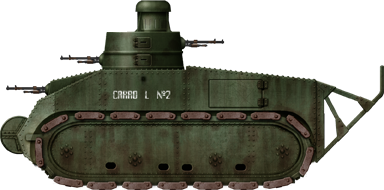
Specifications |
|
| Dimensions | Excluding tail 4.36 x 2.8 x 1.8 m (14.3 x 9.19 x 5.9 ft) |
| Total weight, battle ready | 8.1 tonnes |
| Crew | 3 (Driver/frontal gunner; Commander/gunner/loader; and Gunner/loader) |
| Propulsion | Daimler MV1574 4 cylinder 75 hp |
| Max speed | 30 km/h (19 mph) on road |
| Range | 100 km (62.14 miles) |
| Suspension | None |
| Armament | 3 x 7 mm Hotchkiss M1914 machine guns |
| Armor | 16-20 mm (0.63 – 0.79 in) |
| Production | 4 |
Sources
Artemio Mortera Pérez, Los Carros de Combate “Trubia” (Valladolid: Quirón Ediciones, 1993)
Artemio Mortera Pérez, Los Medios Blindados de la Guerra Civil Española. Teatro de Operaciones del Norte 36/37 (Valladolid: AF Editores, 2007)
Artemio Mortera Pérez, Los Medios Blindados de la Guerra Civil Española. Teatro de Operaciones de Levante, Aragón y Cataluña 36/39 2.ª Parte (Valladolid: AF Editores, 2011)
Chus Neira, “El primer tanque español salió de la Fábrica de Trubia hace 90 años” La Nueva España [Spain], 30 March 2017 (https://www.lne.es/oviedo/2017/03/30/primer-tanque-espanol-salio-fabrica/2081455.html#)

